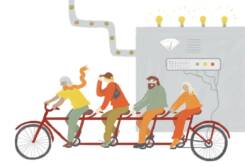Pension providers’ operating expenses
Authorized pension providers are responsible for implementing statutory earnings-related pension insurance. Among their other tasks, they collect pension contributions, manage accrued funds, process pension applications, and grant and pay earnings-related pensions. Operating expenses are funded by a component included in the earnings-related pension contribution, except for investment expenses.
Content of this page
Pension providers’ many tasks
Pension providers put statutory earnings-related pension provision into practice. In this role they are responsible for the following measures:
- collecting earnings-related pension contributions
- collecting the necessary income and other data on employees and self-employed persons
- investment and management of accrued pension assets
- processing pension applications and decision-making
- granting and paying earnings-related pensions.
In addition, pension providers ensure that employees and self-employed persons are informed of the accrual of their pensions on their own pension records. Employers who have taken out insurance, in turn, receive calculations and forecasts of both paid and payable pension contributions.
Pension providers also carry out a wide range of activities that focus on maintaining working capacity and managing disability risks. They offer their clients a variety of services related to coping at work and extending their careers, the purpose being to reduce employees’ risk of disability. In situations where an illness or injury already poses a concrete threat to the ability to work, pension providers arrange vocational rehabilitation for the employee or self-employed person in an effort to enable them to continue working despite the illness or injury.
Investment expenses consist of the activities of the pension provider’s own investment organization and costs related to the use of external services. These costs include, among others, the fees paid to managers of indirect investments.
Information system costs play a big role
Information systems play a key role in all activities undertaken by pension providers. Therefore, the costs of information system also account for a considerable share of total operating expenses. The processes of the earnings-related pension system are largely automated and must adhere to high quality standards in terms of data retention, accuracy, availability and crisis preparedness. To this end, the performance and service level of the systems needed to manage large amounts of data must be dimensioned so as to have a sufficient volume.
The earnings-related pension system has information on current and former employment relationships, wages, accrued earnings and earnings-related pensions for everyone working in Finland. This information is needed, among other things, to calculate pensions for pension decisions, to pay earnings-related pensions and to calculate the liabilities of pension providers.
There is no ready-made software supporting Finnish earnings-related pension legislation, so the systems have been developed on the basis of customized software. In addition, the information systems have had to take into account all the amendments made to earnings-related pension legislation over the decades. As no amendments are retroactive, the pension decisions and calculations made at the present time apply to the pension legislation in force at the time of each event. All old and new legislation must be available as processing rules in information systems.
Information system costs are also affected by the fact that the earnings-related pension system provides comprehensive service for the insured: According to the principle of the last insurer, earnings-related pension is applied for and paid by the latest pension provider of the insured employee or self-employed person. The insured persons themselves need not apply for a pension from all pension providers who have contributed to their insurance during their work history. To enable such a service, the information systems of all pension providers are integrated with each other so that all necessary information for the pension decision can be obtained.
As in the case of applying for a pension, the insured persons receive information from their own pension provider on all their previous employment contracts, even if they had been insured with a different pension provider or in both the private and public sectors.
Operating expenses have two funding sources
Expenses posed by the activities of pension providers are covered by two separate sources of financing.
Expenses (and possible losses) arising from the investments of earnings-related pension assets are funded entirely by investment income. When pension providers report income from their investment activities, they first deduct the share of investment expenses from the reported income.
The operating expenses arising from the pension providers’ other activities are financed using the component included in the earnings-related pension contribution. For example, for pension insurance companies, this component of the contribution intended to cover operating expenses is known as the administrative cost component.
Operating expenses in 2023
According to the most recent financial statements (Financial statements of pension providers in 2023), the total operating expenses of pension providers, i.e. including expenses from own activities, were approximately EUR 601 million. Excluding investment expenses, total operating expenses were approximately EUR 440.2 million.
The income of all earnings-related pension providers from premiums, i.e. the sum collected as earnings-related pension contributions, was approximately EUR 27.0 billion. Thus, the operating expenses financed under the earnings-related pension contribution was on average 1.6 per cent of earnings-related pension contribution income.
Breakdown of operating expenses
If we look at the operating expenses of pension insurance companies in 2023, the operations financed by the earnings-related pension contribution are broken down as follows:
- administrative expenses of pension contributions 30 per cent
- claims handling expenses (e.g. expenses related to the processing of pension applications and payment of pensions) 29 per cent
- expenses related to policy acquisition 16 per cent
- other administrative expenses 14 per cent
- statutory fees 10 per cent.
These figures do not take into account investment expenses or expenses related to the maintenance of working capacity. The costs of investment activities are financed by investment income, while the costs related to the maintenance of working capacity are financed by a separate component included in the earnings-related pension contribution.
Share of information system costs
Information systems play a key role in all the activities of pension providers. Thus, information system costs are included in the management costs of both pension contributions and claims handling, the acquisition of insurance and other administrative expenses.
IT costs financed by earnings-related pension contributions amounted to about EUR 183 million.
The above figure does not include investment IT costs, which are financed by investment income. When the share of investment activities are taken into account, IT expenses totalled about EUR 207 million.

